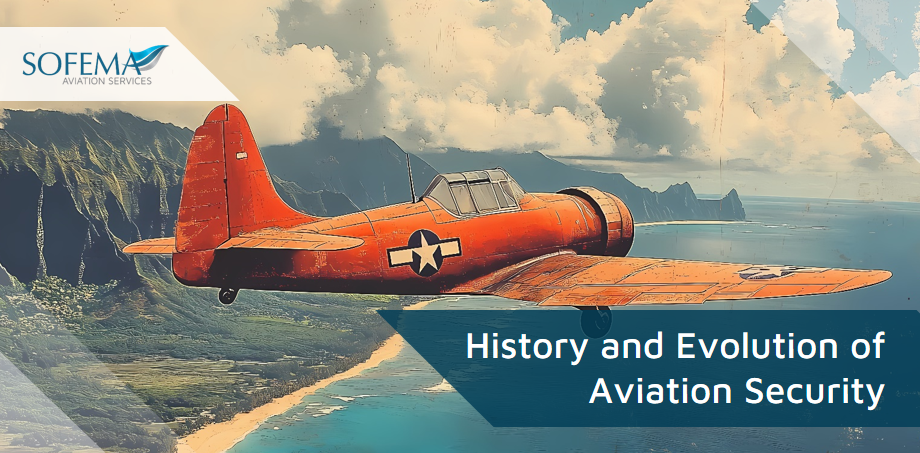Sofema Aviation Services (SAS) www.sassofia.com – considers the evolution of Aviation Security and the related reactive drivers
Aviation security has evolved significantly in response to threats and incidents over time. The development can be broken into milestones, reflecting how regulatory frameworks, technologies, and global practices have changed.
Early Beginnings: The Birth of Aviation Security (1910s-1950s)
- 1910s: The Wright brothers’ first powered flight marked the beginning of aviation. Security was non-existent as aviation was primarily experimental.
- 1931: The first recorded hijacking occurred in Peru, bringing the need for some level of security into awareness.
- The first recorded aircraft hijack took place on February 21, 1931, in Arequipa, Peru. Byron Richards, flying a Ford Tri-Motor, was approached on the ground by armed revolutionaries. He refused to fly them anywhere during a 10-day standoff. Richards was informed that the revolution was successful and he could be freed in return for flying one of the men to Lima
- 1944: The Chicago Convention established the International Civil Aviation Organization (ICAO), setting the stage for a global framework of aviation safety and security.
Notes – Security in the Early Days
- Minimal checks and open airport access were common in the 1940s due to low threat levels and limited aviation activity.
- Early focus was on aircraft safety rather than intentional security threats.
Response to Hijackings and Early Regulations (1960s-1970s)
- 1960s: A surge in aircraft hijackings occurred, particularly in the U.S. and Cuba. Security measures began to include passenger screening.
- 1974: The adoption of Annex 17 by ICAO establishing international standards for safeguarding civil aviation.
>> The rise of hijackings in the 1960s, particularly in the U.S. and Cuba, forced authorities to introduce basic screening processes.
>> The adoption of ICAO Annex 17 (1974) standardized global aviation security measures, introducing screening and safeguarding measures.
>> Initial passenger profiling and armed marshals (Sky Marshals) were introduced to deter hijackers.
Notes Related to Hijackings
- Introduction of metal detectors and baggage screening in response to frequent hijackings.
- The “Sky Marshals” program was introduced in the U.S. to place armed officers on flights.
The Age of Terrorism and Tightened Controls (1980s-1990s)
- 1985: The bombing of Air India Flight 182 over the Atlantic Ocean highlighted the need for enhanced baggage screening.
- 1988: The bombing of Pan Am Flight 103 over Lockerbie, Scotland, led to stricter regulations on cargo and passenger screening.
- 1996: ICAO introduced the Aviation Security Plan of Action to provide a systematic response to threats.
Notes Related to Explosive Detection Systems
- Implementation of Explosive Detection Systems (EDS) for checked luggage.
- Development of the International Civil Aviation Organization’s Aviation Security Training Packages (ASTPs).
Post-9/11 Era: A Paradigm Shift in Aviation Security (2001-2010)
- 2001: The September 11 attacks marked a turning point. The U.S. formed the Transportation Security Administration (TSA), and ICAO reinforced Annex 17 standards.
- 2006: Introduction of restrictions on liquids, aerosols, and gels (LAGs) in response to a foiled terrorist plot.
- 2009: The “underwear bomber” incident spurred the introduction of body scanners.
Notes Related to Post 9/11 Developments
- Development of advanced imaging technologies like millimeter-wave scanners.
- Implementation of Secure Flight programs and Passenger Name Record (PNR) data sharing for international flights.
Modern Era: Embracing Technology and Cybersecurity (2011-Present)
- 2017: Increased focus on cybersecurity threats to aviation systems.
- 2018: The Global Aviation Security Plan (GASeP) was launched by ICAO to enhance global security efforts.
- 2020s: Adoption of Artificial Intelligence (AI) and machine learning for threat detection.
Notes Related to Modern-Era Developments
- Deployment of biometrics and facial recognition at airport security checkpoints.
- Use of predictive analytics to identify potential threats through passenger profiling.
Key Takeaways
- Aviation security has shifted from reactive to proactive measures, leveraging technology and international collaboration.
- Incidents like hijackings and terrorist attacks have significantly influenced regulatory changes and operational practices.
- Future aviation security is likely to focus on integrating advanced technologies and addressing emerging threats like drones and cyberattacks.
- Cybersecurity has emerged as a major concern, with efforts to protect aviation systems from digital threats.
- ICAO GLOBAL AVIATION SECURITY PLAN (GASeP) – The ICAO Council, at the third meeting of its 232nd Session on 10 June 2024, approved the Second Edition of the Global Aviation Security Plan (GASeP) – This Second Edition of the GASeP has been developed as a strategic document to guide States, industry, and ICAO in their efforts to enhance aviation security.
Developments will continue to embrace advanced technologies like biometrics, AI-driven analytics, and predictive security systems became central to modern aviation security.
Next Steps
Follow this link to our Library to find & download related documents for Free.
Sofema Aviation Services and Sofema Online provide Classroom, Webinar, & Online Aviation Safety & Security Training. Please see the websites for details or email team@sassofia.com.
Tags:
ICAO, Aviation Security, SAS blogs, Transportation Security Administration (TSA), Cybersecurity, Early Regulations, Tightened Control, Passenger Name Record (PNR), The Global Aviation Security Plan (GASeP), Adoption of Artificial Intelligence (AI), Modern-Era Developments





